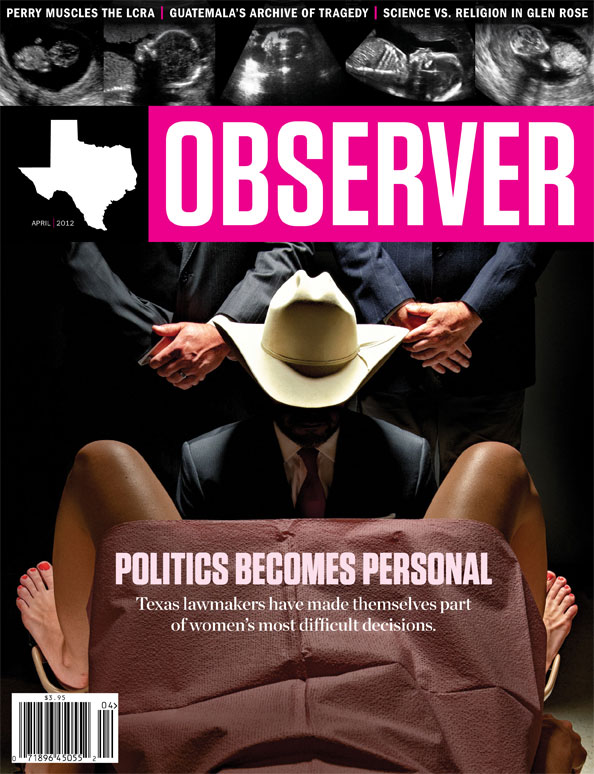In case you’re not familiar with the Texas Observer, you should be. They are doing some great design and photography work. The creative team behind the magazine is EmDash, a graphic design firm founded by Erin Mayes. Their latest cover, conceived (pun intended) by art director Kate Iltis, has gone viral due to its smart and graphic take on the Texas government’s new role in women’s reproductive rights. At last check, Planned Parenthood’s facebook page showed over 10,000 likes and 3,000 comments. We talked with Kate about the concept behind the shoot. Read our interview below.
Personally I would have loved to have seen this without any cover lines, but still, it is a powerful visual representation of the latest developments in Texas’ laws concerning women and abortion.
The photographer who shot this cover prefers to remain anonymous.
Jasmine: Can you tell us a bit about the creative process behind this cover? How did you come up with the concept?
Kate: The challenge for this cover was that the story itself was unique for the Texas Observer. The article was not a simple abortion law story nor was it a straight report on the new sonagram law. It was a first person’s account of the reality of the sonagram law and how it effects Texas women. So when brainstorming we really wanted to address everyday women and how lawmakeres are putting themselves in places they don’t belong. So that is where we came up with the exam room idea and the angle of the shot. It was important for people to put themselves in the shot in order to understand the seriousness of the situation.
How did the cover go viral? Who was the first (that you know of) to write about it?
You know I am not sure about that. The editor emailed us about the twitter response and then we heard that Planned Parenthood’s National facebook page endorsed it. We got 3,000 likes in the first twelve minutes. Then we watched it go from there.
Did you expect it to garner so much interest online?
No, because we mostly live in the print world so I didn’t really think about it. I knew it was a powerful cover and I knew we probably would be stirring things up but never expected that quick of a response from so many. It surpassed our print run in the first 24 hours.
What’s your reaction to the reaction?
We are all really excited about the reaction. I think as a magazine designer you produce work and send it into the world not sure if people are interested. You just try to focus on doing good work and hope for the best. The fact that this photo engaged people enough for them to respond, share the article and even better to criticize, means we did our job and that magazines still work! The reaction was mixed which I think means we walked the delicate line of being powerful versus offensive. People are talking and that is a good thing.
What’s the most surprising piece of feedback you’ve heard or read about the cover?
There was a lot of debate about this cover before we released it wondering if we had gone too far. But we all agreed that it was uncomfortable but it was honest which in turn made it powerful. That was the intent and I guess I was surprised that for the most part people agreed. But I have to say the ones that surprised me the most were the funny comments like “Forget who shot J.R., who shot that cover” and “If the Texas government wants to control my vajayjay, they better darn well know what it looks like…great cover.”
Did you hire someone to help produce this shoot and source those cowboy hats? Because the styling is perfection!
Thank you! To answer your question the styling is all home grown. The Texas Observer is a non profit magazine so our budget is very small. Whenever we produce a photo shoot we do everything ourselves thru the kindness and patience of our friends and employees. But as a general prop rule, you can never go wrong with a Stetson.
I imagine a lot more photographers are going to be knocking at your door. What’s something they should know about pitching themselves to your magazine?
That would be great if they did. The only caveat with the Observer is that the budget is small but we push for the ideas to be big. Working with the Texas Observer feels like you are part of a grassroots movement and there is a lot of creative freedom there. There’s a mission that getting to the truth is more important than offending advertisers and readers, and that’s really unusual in the land of publishing.




